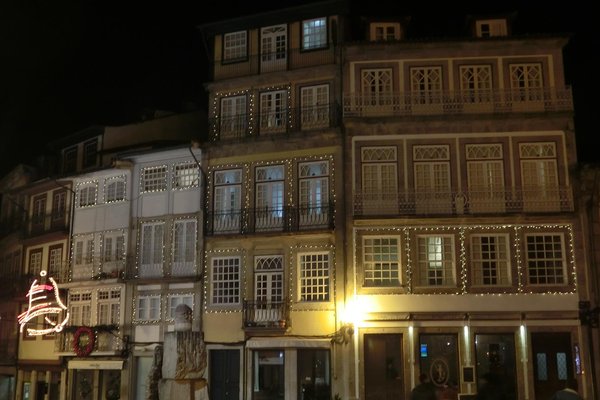Portugal
Guimarães
The Historic Centre of Guimarães and Couros Zone are known for their medieval building techniques, which have been transmitted to the Portuguese colonies in Africa and the Americas.
The town’s early history (12th century) is tied to the Portuguese national identity and the Portuguese language. From the 15th to the 19th centuries, its typical traditional building technique using granite mixed with a timber-framed structure evolved.
Community Perspective: The castle is the town’s focal point; it also has a pretty medieval quarter with many colorful balconied houses and nice churches.
Site Info
Official Information
- Full Name
- Historic Centre of Guimarães and Couros Zone (ID: 1031)
- Country
- Portugal
- Status
-
Inscribed 2001
Site history
History of Guimarães
- 2023: Extended
- To include two monastic complexes and an industrial area, the Couros Zone.
- 2023: Name change
- From "Historic Centre of Guimarães" to "Historic Centre of Guimarães and Couros Zone"
- 2001: Inscribed
- Inscribed
- Type
- Cultural
- Criteria
- ii
- iii
- iv
Links
- UNESCO
- whc.unesco.org
- Official
-
- visitportugal.com — Visit Portugal: Guimaraes
All Links
UNESCO.org
- whc.unesco.org — whc.unesco.org/
Official Website
- visitportugal.com — Visit Portugal: Guimaraes
Community Information
- Community Category
- Urban landscape: Medieval European
- Urban landscape: Post-medieval European
Travel Information
Recent Connections
-
Perfect Inscriptions
2001 -
Depicted in Mizielinska Maps
CastleSee i.pinimg.com
-
Name changes
Upon extension: from "Historic Centre o…
Connections of Guimarães
- Trivia
-
-
Replica in Mini-Europe
-
Depicted in Mizielinska Maps
CastleSee i.pinimg.com
-
Google Doodles
10 June 2016, Portugal National Day 2016See www.google.com
-
On Euro coins
Commemorative 2 euro coin Portugal 2012 -
On Passports
Portuguese passportSee www.pep.pt
-
- History
-
-
Declarations of Independence
June 24, 1128: Portugal from the Kingdom of L?on -
Located in a Former Capital
Portugal 1095 - 1131 -
Coronation Locations
-
- Architecture
-
-
Timber framing
taipa de rodízio, a half-timbered structure, which mixed granite with a structure in timber and a filling of sun-dried brick, using clay mortar (AB ev) -
Manueline style
-
- World Heritage Process
-
-
Perfect Inscriptions
2001 -
Extended
2023
-
- Human Activity
-
-
Famous tapestries
Palace of the Dukes of Braganza: "In its vast collection, are the tapestries of Pastrana, which narrate some of the events in North African conquests, attributed to Nuno Gonçalves ... and a collection of Flemish tapestries by Peter Paul Rubens, among others"
-
- WHS on Other Lists
- Timeline
-
-
Built in the 12th century
The early history of Guimaraes is closely associated with the establishment of Portuguese national identity and the Portuguese language in the 12th century
-
- WHS Hotspots
- WHS Names
-
-
Name changes
Upon extension: from "Historic Centre of Guimarães" to "Historic Centre of Guimarães and Couros Zone"
-
News
No news.
Recent Visitors
Visitors of Guimarães
- AC
- Adam Hancock
- Adolfo
- Adrian Turtschi
- Alberto Rodriguez Gutierrez
- alex
- Alexander Barabanov
- Alexander Lehmann
- Alexander Parsons
- alicemears
- Aljaz
- A. Mehmet Haksever
- Ammon Watkins
- Ana Lozano
- Andrew_Kerr
- Anna Wludarska
- Argo
- Aspasia
- Atila Ege
- AYB
- BaziFettehenne
- Bill Maurmann
- Bin
- BobSmithseestheworld
- Brendan Carroll
- brornt
- Bruno_Pires
- Can SARICA
- Catoplayer
- Cezar Grozavu
- chenboada
- Cheryl
- Christoph
- Christravelblog
- Cirene Moraes
- Claire Bradshaw
- Clyde
- Coppi
- Corinne Vail
- Cristina Erba
- Csaba Nováczky
- CugelVance
- Cyberczar
- Dagmara
- Daniela Hohmann
- Daniel Chazad
- Daniel Gabi
- dankir
- Dan Pettigrew
- David Berlanda
- DavidS
- del
- Dimitar Krastev
- Dimitrios Polychronopoulos
- Dolemite92
- Dorejd
- Dr. Caligari
- Dwight Zehuan Xiao
- Echwel
- edstar500
- Elia Vettorato
- Elis
- eljx1988
- Els Slots
- Emilia
- Erfe91
- Errol Neo
- Eva Kisgyorgy
- Evgenii
- Fan Yibo
- Farinelli
- Federico P.
- Feldhase
- Felicité
- Femke Roos
- Filip Murlak
- FK
- Frédéric M
- Frederik Dawson
- FS
- Geert Luiken
- George Gdanski
- GeorgeIng61
- Gernot
- Gilles
- Grzegorz Andruszkiewicz
- Hadrianus
- Harald T.
- Harry Mitsidis
- Hubert
- Iain Jackson
- Ilya Burlak
- Ivan Rucek
- Jaakkotoivanen
- Jakob F.
- Jana and Matt
- janameerman
- Janina Lehmann
- Jarek Pokrzywnicki
- Jasam
- Jay T
- Jean Lecaillon
- Jeanne OGrady
- Jens
- Jezza
- João Aender
- JobStopar
- Joel on the Road
- John Smaranda
- Jonas Hagung
- Jonas Kremer
- Jonas Martinsson
- jonathanfr
- Jon Eshuijs
- jonstst
- JR's HERITAGE SITES
- Jurre
- jxrocky
- Karito Vies
- Kasia M.
- Ken DJ
- KentishTownRocks
- krtek
- Krzysztof B
- Kurt Lauer
- Lara Adler
- LaVale
- Liamps91
- lichia
- Lithobates
- ljowers
- Loic Pedras
- Luboang
- Lucio
- Ludvan
- Luis Filipe Gaspar
- Maciej Gil
- Malgorzata Kopczynska
- manuel011197
- Manuelfunk
- marc Rouserez
- Marlies van Wolfswinkel
- Martina Rúčková
- Marty
- Mathijs
- MAURO PODDA PANI
- MaYumin
- MH
- M. Huineman
- Mia esguerra
- Michael Novins
- Miguel Marquez
- Mihai Dascalu
- Mikan22
- Mikko
- Milan Jirasek
- MMM
- MoPython
- Msarmiento1979
- Mtlmr
- Naim Y
- nan
- napalm
- Nick M
- Nihal Ege
- nikolamus
- PabloNorte
- Palimpsesto
- Patrik
- Paul Schofield
- Peter Lööv
- Petteri
- Philipp Leu
- Philipp Peterer
- phillipmeng
- Pink Bunny
- Piotr Wasil
- Potsdamer
- Rafabram
- Ralf Regele
- Randi Thomsen
- Remski
- Reza
- Rick Ohm
- Roccobot
- Roel Sterken
- Roger Ourset
- Roman Bruehwiler
- Sabrina Liebehentschel
- Samy G
- Sandmann15
- Schnitzel
- Sclowitz
- SDMArado
- Shandos Cleaver
- Shijie ZHU
- sibariam
- sime147
- Slavi
- Solivagant
- Spike Zou
- Stan
- Stanislaw Warwas
- stephanvermeulen
- Stijn
- Sturuss
- Svein Elias
- Szabolcs Mosonyi
- Szucs Tamas
- Tamara Ratz
- Taotao Chen
- Tarquinio_Superbo
- Tevity
- Thomas Buechler
- Thomas Harold Watson
- Thomas van der Walt
- Thorben
- Tim Allen
- tony0001
- triath
- Truls Brekke
- Tschibi
- Twobaconsandaboston
- usagi1974
- Vanessa Buechler
- Vernon Prieto
- Viaje al Patrimonio
- voyager
- Walter
- Wojciech Fedoruk
- Xander Huang
- Xiquinho Silva
- Zoë Sheng
- Zos M
Community Reviews
Show full reviews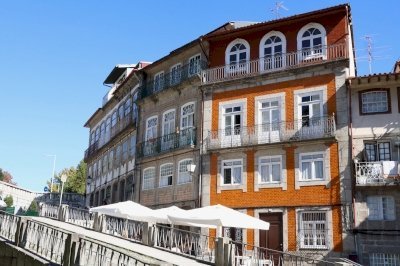
October 2020 - this was my highlite whs on the Portugal trip. Guimareas is a wonderful, historic town with a very specific architecture. Many of the houses have tiled walls and characteristic wooden balconies. We parked next to the castle and toured through the city. Due to Covid, the town was probably not as packed as it is normally due to tourists combining it with Porto.The town has several sights, the medieval castle and the palacio ducal, which both have a very British character, the camara municipal with its big yard where children were playing, the Igreja e de Nossa Senhora da Consolação which stands on a roundabout but still is not loosing its charme, the Couro-zone where clothes were dyed and of course the main praca de São Tiago with the framework houses, the porticoes which lead you to further churches and squares. Somewhat like an ideal medieval town which you would build from Lego bricks. There are so many other things to visit but we had to find a laundry. In the evening hours we returned again, Guimareas turned into a Christmas market. Fairy lights on all the balconies painted the town into a cozy yellow. Just before closing we still had a Portwine in the wonderful Artdeco Milenial Cafe (very authentic). After this perfect sightseeing day, we fell asleep in our camper to continue to Braga next morning.
Keep reading 0 comments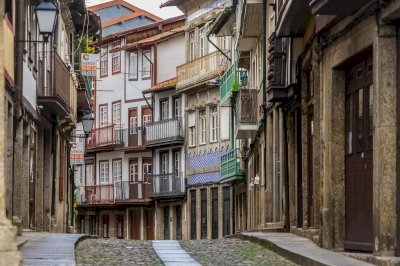
The first capital of Portugal way back in the 12th century, Guimarães is recognized on the World Heritage list as an authentic example of the evolution of a medieval settlement into a modern town. Its historic center is a homogeneous architectural ensemble in a style that in native to the country and to the area, preserved well enough to offer visual enjoyment around every corner.
Palace of the Dukes of Braganza is the leading tourist attraction in town. Although not “must-see” in the absolute sense of the word, it is quite interesting in that it manages to project a proper medieval feel in its mix of grand spaces with the austerity that is only mildly pierced by the placement of decorative objects. The palace chapel is rather sparsely lighted inside, which makes the sight of its stained glass windows all the more dramatic.
The nearby 11th-century castle is among the oldest structures in town. As Guimarães is widely considered to be the cradle of Portuguese national identity, the castle claims to be the likely place of birth of the first king of Portugal, Afonso Henriques. The most fun part of the visit to the castle is the animated biopic of Afonso Henriques shown on the top floor of the keep – you don’t have to understand Portuguese to enjoy the lighthearted way of the presentation. The history of the country – alongside some of the key world events – is presented chronologically on the lower levels from medieval …
Keep reading 0 comments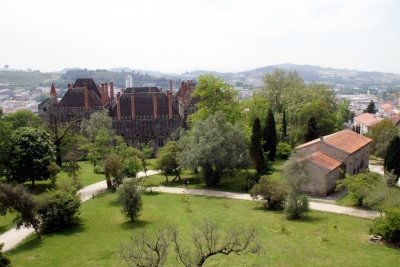
For today's visitors, it is not immediately apparent that Guimarães played such a significant role in Portuguese history, it is closely related to the foundation of the Portugal and is often referred to as the "cradle of the nation". The Castelo de Guimarães is said to be the birthplace of the first king of Portugal, Alfonso Henriques. Thus it's a good idea to refresh your knowledge about the origins of the Portuguese nation prior to the visit. If not, you can learn the most important facts in the small exhibition at the Castelo. They show also a copy of the Manifestis Probatum, the papal bull in which Pope Alexander III recognized the Portuguese king and confirmed the independence of Portugal from the Kingdom of Castile.
The castle looks just like one imagines a medieval castle: a central keep surrounded by a ring of high walls and eight crenellated towers. You can walk on top of the wall around the entire castle, the photo shows the view to the two other buildings in the small park, the Paço dos Duques de Bragança and the Igreja de São Miguel.The Bragança Palace was built in the 15th century and was for several decades the residence of the Dukes of Bragança until they moved to Vila Viçosa. The Palace has a quadrangular plan and is built strictly symmetrical around a large courtyard, most striking are the high brick chimneys and the sloping roofs. The interior is rather austere and simple. Parts of the …
Keep reading 0 comments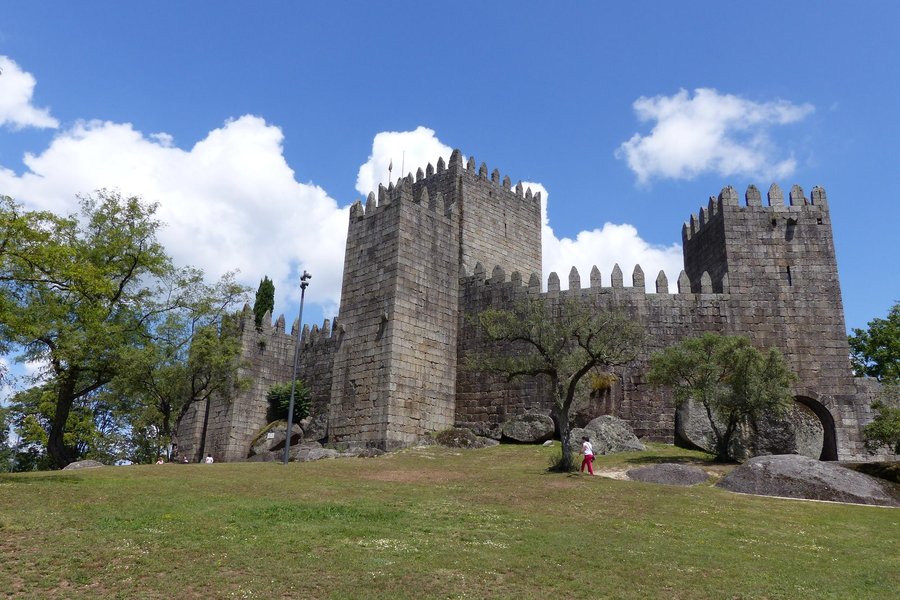
I visited Guimarães from Porto. Just a day trip. It was one of the many UNESCO sites I would visit this road trip.
I loved the place! It was a Sunday and very quiet but made it easy for photography. Parking you can do best at the castle and from there walk to the palace of the dukes, then continue to Olive Square. Then circle back wandering the small streets with the medieval half wooden houses.
Highly recommended!! A photo gallery you can see on the link.
Keep reading 0 comments
We stayed one night in Guimarães in October 2015, which was quite sufficient for this small town. I chose nice hotel within the old city walls called the Toural.
The town's castle dates back to the tenth century, and still stands solid and imposing at the town’s highest point. They don’t charge an entrance fee to get in, and you can appreciate some pleasant views of the hilly surrounding countryside. The town’s medieval quarters have remained largely unchanged since they were built. The Portuguese are keen on colourful tile patterns, as we saw the next day at Porto’s famous São Bento station.
The Portuguese national identity isn't something that has much significance to me – I had only ever visited the country once before! But it was nonetheless a pleasant, relaxing place to visit, and an opportunity to sample ‘small-town’ Portugal – as opposed to the big-town bustle of Lisbon and Porto.
Keep reading 0 comments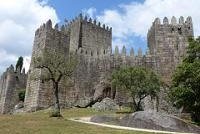
I visited this WHS in August 2014. I spent 2 nights here and I wasn't disappointed. Guimaraes has quite a lot to offer for those who decide to visit at leisure. The Guimaraes castle is one of the main landmarks (free entrance) together with the Oliveira Square and Toural Square. I was lucky enough to visit on the first Sunday of the month which meant that the Palace of the Dukes of Braganza was free too. Moreover, there was the local parish feast when I visited which meant that the main churches were in tiptop condition and fully lit. My personal favourite was the Church of St Francis with its over-the-top interior.
Keep reading 0 comments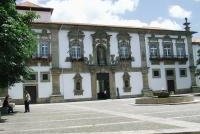
Other interesting features in Guimaraes were the five Stations of the Cross to be found around the town, the church of Our Lady of the Olive Tree and the Santa Clara convent.
Keep reading 0 comments
Guimarães is all up and downs, hill after hill. It is very beautiful and it whispers the stories of old times.
The sidewalks are decorated with stones, many different colors and figures.
For finnish people, it is funny to see flags -very similar as finnish flag- hanging all over the old town. This blue crossed white flag is the old Portugese flag from the time of kindom.
Keep reading 0 comments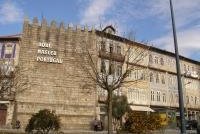
As you enter Guimarães, a small historic town in northern Portugal near Porto, you may think this is just a normal Portuguese old town until you see a huge inscription “AQUI NASCEU PORTUGAL” on the building which means “Here is the birthplace of Portugal” then you know this town is quite special (at least).
Guimarães is associated with Portuguese first true king, Afonso Henriques who drove the Moors out of Tejo river area which is now central Portugal. His castle on the hill above the old town is quite spooky with many turrets but enchanted by medieval felling. Near the castle is the recent restored Ducal Palace or presidential palace which is famous for it chimneys, however it is not interesting compared to the castle since it is just a big manor.
The old town is a very pretty medieval quarter with many colorful balconied houses and nice churches. The symbol of the city is its unique 14th century town hall which was constructed on many pillars. My favorite is Igreja de Sao Gualter with its beautiful façade and lovely esplanade in front of the church.
Guimarães is a nice lovely town and very important for Portuguese; however, for foreigner like me this town is not special as I had expected. The town is so small and I spent only half day to see all attractions. I did not conclude that Guimarães is not a good place, the town is beautiful but when compared to Porto or Braga, Guimarães is …
Keep reading 0 comments
Guimaraes is a cute little town at the foot of a mountain. Its not spectacularly amazing but it does exude a certain Iberian charm that is so typcial in these part of the world
Keep reading 0 comments
